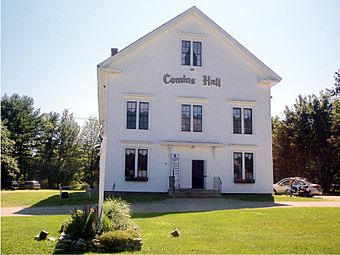Comins Hall facts for kids
Quick facts for kids |
|
|
East Eddington Public Hall
|
|
 |
|
| Location | 1387 Main Road, Eddington, Maine |
|---|---|
| Area | 1.4 acres (0.57 ha) |
| Built | 1879 |
| Architect | John James Temple |
| Architectural style | Italianate |
| NRHP reference No. | 03001503 |
| Added to NRHP | January 28, 2004 |
Comins Hall, also known as the East Eddington Public Hall, is a special old building in Eddington, Maine. It's located at 1387 Main Road. This hall was built way back in 1879. For a long time, it has been the main place for people in town to meet and have fun. It has hosted many important events like town meetings, dances, dinners, and even shows by traveling performers. It was added to the National Register of Historic Places in 2004 because of its important history.
Contents
What Does Comins Hall Look Like?
Comins Hall is in the village of East Eddington. It's a two-and-a-half-story building made of wood. It has a roof that points forward and a strong stone foundation. The outside of the building has a classic style called Italianate. You can see this style in the paired windows and the small roof-like cover over the main door.
Inside the Hall
When you go inside, there's a small entrance area with a ticket booth. Stairs wind up from here. On the first floor, there's a large dining room with a kitchen. Upstairs, on the second floor, you'll find a big auditorium with a stage. This stage was added later, in 1911.
The History of Comins Hall
The hall was built in 1879 as a community project. A local carpenter named John James Temple led the building work. It was first built for the East Eddington Farmers' Club. This club started in 1876, and farmers would meet there to talk about new ways to farm.
From Club to Community Center
The Farmers' Club created a separate group called the East Eddington Public Hall Company. This company owned and managed the building for many years. In 1983, the Eddington-Clifton Civic Center took over the building. They renamed it Comins Hall to honor a local family who helped a lot with community activities.
A Hub for the Community
Since it was built, Comins Hall has been a very important place for the town. It was used as a place to vote and for town meetings. From 1936 to the 1970s, it was the only place where town meetings were held. Many local groups, like the local Grange chapter, used the hall for free. With its stage, it also became a popular spot for plays and shows.
See Also



